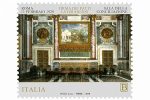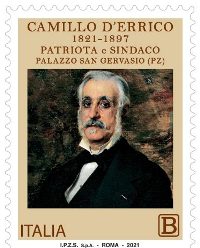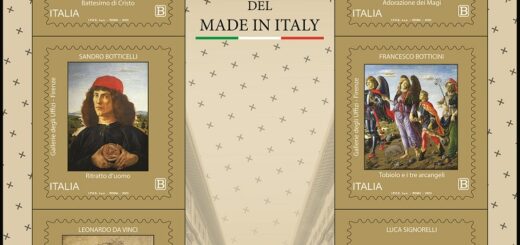POSTE ITALIANE 4^ emissione anno 2019 “francobollo celebrativo del 90° anniversario della firma dei Patti Lateranensi ”
Titolo: Emissione di un francobollo celebrativo del 90° anniversario della firma dei Patti Lateranensi.
Il Ministero emette il giorno 11 febbraio 2019 un francobollo celebrativo del 90° anniversario della firma dei Patti Lateranensi (emissione congiunta con la Città del Vaticano), relativo al valore della tariffa B pari a 1,10€.
Patti Lateranensi è il nome che è stato stabilito per gli accordi di mutuo riconoscimento tra il Regno d’Italia e la Santa Sede sottoscritti l’11 febbraio 1929, con i quali per la prima volta dall’Unità d’Italia furono stabilite regolari relazioni bilaterali tra Italia e Santa Sede.
Presero il nome del Palazzo di San Giovanni in Laterano in cui avvenne la firma degli accordi, che furono negoziati tra il Cardinale Segretario di Stato Pietro Gasparri per conto della Santa Sede e il Capo del governo primo ministro segretario di Stato Benito Mussolini per conto del Regno d’Italia.
Il contenuto dei Patti
- il Trattatoriconosce l’indipendenza e la sovranità della Santa Sede che fondava lo Stato della Città del Vaticano;
- la Convenzione finanziariache prevedeva un risarcimento di 750 milioni di lire a beneficio della Chiesa; regolava cioè le questioni sorte dopo le spoliazioni degli enti ecclesiastici a causa delle leggi eversive. È stata inoltre prevista l’esenzione, al nuovo Stato denominato «Città del Vaticano», dalle tasse e dai dazi sulle merci importate.
- il Concordato che definiva le relazioni civili e religiose in Italia tra la Chiesa e il Governo. Il rapporto precedente (regolato dalla Legge delle Guarentigie), nel quale ancora vigeva la norma del giuramento dei nuovi vescovi al Governo italiano, l’unico vescovo che non era obbligato a giurare fedeltà all’Italia era colui che fa le veci del Pontefice nella sua qualità di vescovo di Roma, cioè il cardinale vicario. Questa eccezione alla regola, che appariva nel Concordato, era stata prevista proprio in segno di rispetto dell’indipendenza del Papa da parte dell’Italia. Il governo italiano acconsentì di rendere le sue leggi sul matrimonioe il divorzio conformi a quelle della Chiesa cattolica di Roma e di rendere il clero esente dal servizio militare. I Patti garantirono alla Chiesa il riconoscimento del cattolicesimo quale religione di Stato in Italia, con importanti conseguenze sul sistema scolastico pubblico, come l’istituzione dell’insegnamento della religione cattolica, già presente dal 1923 e tuttora esistente seppure con modalità diverse.
Cenni storici
I Patti Lateranensi non furono gli unici accordi stipulati negli anni successivi alla Prima guerra mondiale tra il Vaticano e stati esteri, nell’ottica di rendere libera la professione della religione cattolica e di ridare un ruolo diplomatico di primo piano al papato.
Gli accordi politici
I Patti Lateranensi (la «Conciliazione») tra Stato e Chiesa nel 1929 per la risoluzione della “Questione romana” si conclusero in maniera soddisfacente per le parti in causa.
Finalmente il 26 agosto 1926 furono designati ufficiosamente e informalmente due incaricati: uno dal governo Mussolini e l’altro da parte di papa Pio XI.
Per la prima volta figura l’avvocato concistoriale Francesco Pacelli quale plenipotenziario per il Vaticano, fratello di Eugenio Pacelli, futuro segretario di Stato prima e papa Pio XII poi. Da parte italiana fu scelto Domenico Barone.
Il 23 aprile 1929 cominciò il dibattito in Senato per la ratifica dei Patti Lateranensi, dibattito concluso il 25 maggio con un voto a favore, al termine di vivaci discussioni e polemiche anche all’esterno del Senato stesso. Sei senatori votarono contro l’approvazione: fra essi Benedetto Croce. Anche la Camera dei deputati votò l’approvazione dei Patti, ma vi furono due dissenzienti, anche se la Camera era formata completamente da elementi del Partito fascista. Lo scambio delle ratifiche avvenne con una solenne cerimonia in una saletta dei Palazzi apostolici, con Mussolini, che vestiva l’uniforme diplomatica con la feluca, ricevuto con tutti gli onori. Era il 7 giugno 1929. Dopo un’ora dalla partenza di questi dal Vaticano, alle dodici in punto, entrarono in vigore i Patti, e nacque lo Stato della Città del Vaticano, con lo scambio delle consegne tra i Carabinieri, che subito dopo lasciarono l’ex territorio italiano passato al Vaticano, e le Guardie Svizzere in alta uniforme. Il clima era di grande cordialità e di amicizia.
Alle ore zero dell’indomani, 8 giugno, entrarono in vigore le sei leggi principali del nuovo Stato, promulgate dal Pontefice subito dopo il mezzogiorno del giorno 7, fra cui la Legge Fondamentale, che all’art. 1 prevede che il Sommo Pontefice è sovrano dello Stato della Città del Vaticano.
L’inserimento nella Costituzione
Nel 1948 i Patti furono riconosciuti costituzionalmente nell’articolo 7, con la conseguenza che lo Stato non può denunciarli unilateralmente come nel caso di qualsiasi altro trattato internazionale, senza aver prima modificato la Costituzione. Qualsiasi modifica dei Patti deve inoltre avvenire di mutuo accordo tra lo Stato e la Santa Sede, in tal caso la revisione dei Patti non richiede un procedimento di revisione costituzionale.
La revisione del 1984: il nuovo concordato
Il Concordato (ma non il Trattato) fu rivisto, dopo lunghissime e difficili trattative, nel 1984, fondamentalmente per rimuovere la clausola riguardante la religione di Stato della Chiesa cattolica in Italia. La revisione che portò al nuovo Concordato venne firmata a Villa Madama, a Roma, il 18 febbraio dall’allora presidente del Consiglio Bettino Craxi, per lo Stato italiano, e dal cardinale Agostino Casaroli, Segretario di Stato, in rappresentanza della Santa Sede. Nel precedente Concordato, nel quale ancora vigeva la norma del giuramento dei nuovi vescovi al Governo italiano, l’unico vescovo che non era obbligato a giurare fedeltà all’Italia era colui che fa le veci del Pontefice nella sua qualità di vescovo di Roma, cioè il cardinale vicario. Questa eccezione alla regola, che appariva nel Concordato, era stata prevista proprio in segno di rispetto dell’indipendenza del Papa nei riguardi dell’Italia. Fu anche stabilito che nelle scuole si potesse richiedere l’esenzione dall’ora di religione cattolica, prima obbligatoria, che tuttavia restò curriculare, mancando l’occasione di rendere al contrario facoltativa la frequenza per gli interessati a tale materia: la scelta relativa deve essere effettuata e comunicata all’atto dell’iscrizione prima dell’inizio dell’anno scolastico.
Se sei interessato ad acquistare questo francobollo, lo puoi acquistare al prezzo di € 1.40. Inviami una richiesta alla email: protofilia1@gmail.com
If you are interested in buying this stamp, you can buy it for € 1.40. Send me a request to the email: protofilia1@gmail.com
Title: Issue of a postage stamp commemorating the 90th anniversary of the signature of the Lateran Pacts.
Patti Lateranensi is the name that was established for the mutual recognition agreements between the Kingdom of Italy and the Holy See signed on 11 February 1929, with which for the first time from the Unification of Italy regular bilateral relations were established between Italy and the Holy See.
They took the name of the Palazzo di San Giovanni in Laterano where the agreements were signed, which were negotiated between the Cardinal Secretary of State Pietro Gasparri on behalf of the Holy See and the Head of Government Prime Minister State Secretary Benito Mussolini on behalf of the Kingdom Italy.
The contents of the Pacts
- the Treaty recognizes the independence and sovereignty of the Holy See which founded the Vatican City State;
- the Financial Agreement which provided for compensation of 750 million lire for the benefit of the Church; that is, it regulated matters arising after the dissolution of ecclesiastical bodies because of the subversive laws. The exemption, in the new State called “Vatican City”, from the taxes and duties on imported goods was also provided for.
- the Concordat that defined civil and religious relations in Italy between the Church and the Government. The previous report (regulated by the Law of Guarantigie), in which the norm of the oath of the new bishops to the Italian Government still existed, the only bishop who was not obliged to swear allegiance to Italy was the one who takes the place of the Pope in his quality of bishop of Rome, that is the vicar cardinal. This exception to the rule, which appeared in the Concordat, had been foreseen as a sign of respect for Italy’s independence of the Pope. The Italian government agreed to make its marriage and divorce laws compliant with those of the Roman Catholic Church and to render the clergy exempt from military service. The Pacts granted the Church the recognition of Catholicism as a state religion in Italy, with important consequences on the public school system, such as the establishment of the teaching of the Catholic religion, already present since 1923 and still existing although in different ways.
Background
The Lateran Pacts were not the only agreements stipulated in the years following the First World War between the Vatican and foreign states, with a view to freeing up the profession of the Catholic religion and restoring a diplomatic role of prominence to the papacy.
Political agreements
The Lateran Pacts (the “Conciliation”) between State and Church in 1929 for the resolution of the “Roman Question” ended satisfactorily for the parties involved. Finally on August 26, 1926, two officers were unofficially and informally appointed: one by the Mussolini government and the other by Pope Pius XI. For the first time, the consortial lawyer Francesco Pacelli is a plenipotentiary for the Vatican, brother of Eugenio Pacelli, the future secretary of state and then Pope Pius XII. Domenico Barone was chosen on the Italian side.
On 23 April 1929 the Senate debate began for the ratification of the Lateran Pacts, a debate concluded on 25 May with a vote in favor, at the end of lively discussions and polemics even outside the Senate itself. Six senators voted against the approval: among them Benedetto Croce. Even the Chamber of Deputies voted for the approval of the Pacts, but there were two dissenters, even if the Chamber was completely formed by elements of the Fascist Party. The exchange of the ratifications took place with a solemn ceremony in a room of the Apostolic Palaces, with Mussolini, who wore the diplomatic uniform with the felucca, received with all honors. It was June 7, 1929. After an hour from the departure of these from the Vatican, at twelve o’clock, the Pacts came into force, and the Vatican City State was born, with the exchange of deliveries between the Carabinieri, who immediately left the former Italian territory passed to the Vatican, and the Swiss Guards in full uniform. The climate was of great cordiality and friendship.
At noon the next day, 8 June, the six principal laws of the new State came into force, promulgated by the Pope immediately after midday on the 7th, including the Basic Law, which in art. 1 provides that the Supreme Pontiff is sovereign of the Vatican City State.
Inclusion in the Constitution
In 1948 the Pacts were constitutionally recognized in Article 7, with the consequence that the State can not denounce them unilaterally as in the case of any other international treaty, without having first amended the Constitution. Any modification of the Pacts must also take place by mutual agreement between the State and the Holy See, in which case the revision of the Pacts does not require a constitutional review procedure.
The 1984 revision: the new arrangement
The Concordat (but not the Treaty) was revised, after long and difficult negotiations, in 1984, basically to remove the clause concerning the state religion of the Catholic Church in Italy. The revision that led to the new Concordat was signed at Villa Madama, in Rome, on 18 February by the then President of the Council Bettino Craxi, for the Italian State, and by Cardinal Agostino Casaroli, Secretary of State, representing the Holy See. In the previous Concordat, in which the norm of the oath of the new bishops to the Italian government still existed, the only bishop who was not obliged to swear allegiance to Italy was the one who acts as parish priest in his capacity as bishop of Rome, that is the vicar cardinal. This exception to the rule, which appeared in the Concordat, had been foreseen as a sign of respect for the Pope’s independence with regard to Italy.
It was also established that in schools one could request exemption from the Catholic religion, which was first obligatory, but which remained curricular, lacking the opportunity to make optional the frequency for those interested in this subject: the relative choice must be made and communicated at the time of enrollment before the start of the school year.
Se sei interessato ad acquistare questo francobollo, lo puoi acquistare al prezzo di € 1.40. Inviami una richiesta alla email: protofilia1@gmail.com
If you are interested in buying this stamp, you can buy it for € 1.40. Send me a request to the email: protofilia1@gmail.com
| data /date | 11 Febbraio 2019 |
| dentellatura/Serration | 11 adesivo |
| stampa/printing | fustellatura – rotocalco |
| tipo di carta/paper type | bianca patinata neutra |
| stampato | I.P.Z.S. Roma |
| tiratura | 600.000 |
| fogli/sheet | 28 |
| dimensioni/dimensions | 48 x 40 mm |
| disegnatore /designer | |
| costo / price | B = €1.10 |
| num. catalogo / catalog num. | Michel 4089 YT3850 UN3932 |







